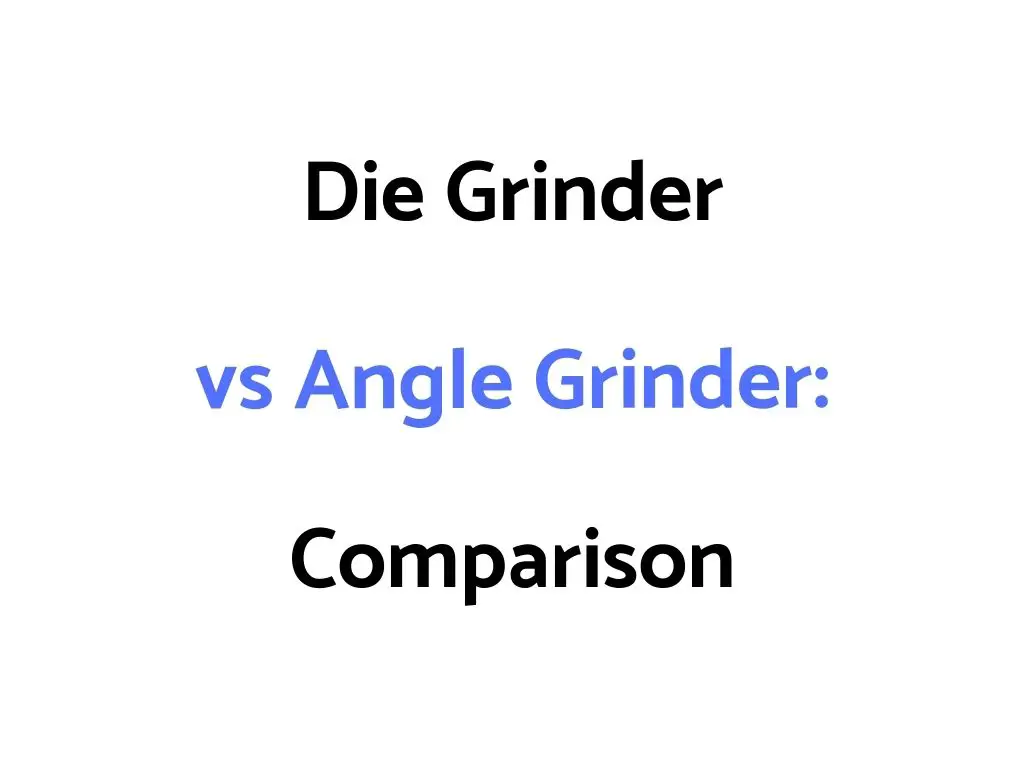There are several key differences, but also similarities when comparing a Die Grinder vs Angler Grinder.
Overall, a die grinder will be better for you for smaller, lighter and more precise tasks.
Whilst an angle grinder has more power and is better for bigger and heavier tasks where precision and accuracy isn’t as much of an objective.
It should also be noted that most Die Grinders come as pneumatically (air) powered, so running a die grinder usually involves also running an air compressor.
Let’s have a look in more detail at Die Grinders vs Angle Grinders and see which might be a better tool for your intended use …
Die Grinder vs Angle Grinder: Differences, Similarities, Which Is Better?
Die Grinder vs Angle Grinder – Differences
1. Angle grinders tend to be bigger and heavier
As a tool, angle grinders tend to be bigger in dimensions and weight.
An average die grinder might be 5 inches in length, and 1lb.
An average angle grinder might be 12 inches in length, and 6 + lbs.
2. Die Grinders tend to be mainly air powered
Most die grinders tend to be air powered tools, although you can get electric die grinders too.
With air die grinders, you will have to power them from an air compressor.
Different die grinders may need different amounts of CFM (cubic feet of air per minute) – so consider that when picking a die grinder and an appropriate sized air compressor.
Angle grinders on the other hand are mainly electrically powered.
3. Angle Grinders are more powerful
Angle grinders tend to be much more powerful tools.
The average angle grinder might be about 1.8 horsepower, while the average die grinder might be 0.25 horsepower.
4. Die Grinders spin faster
Die grinders tend to have smaller discs and attachments – so, the distance the disc or attachment has to spin is less.
As a result, die grinders tend to have faster RPM.
The average die grinder might spin at say 21,000 RPM, whereas the average angle grinder might spin at 11,000 RPM.
5. Angle Grinders tend to be better for bigger, heavier and less precise/more power based applications
Angle grinders tend to have bigger and heavier duty cutting and grinding discs, and are more powerful in terms of horsepower.
As a result angle grinders would be better for cutting thick steel pipes and beams for example.
You can get a relatively straight cut, but maybe not as precise as you would get with a smaller, thinner die grinder blade.
6. Angle grinders are mainly used for grinding and cutting
Angle grinders have two main types of wheels – Type 1 Cutting Wheels, and Type 27 Grinding Wheels.
There are also type 29 flap wheels.
Angle grinders can be used with other types of wheels and attachments – but these are usually the main ones they use.
7. Angle Grinders have bigger discs
Angle grinder discs can be:
4½ inch – 115mm (most common)
5 inch – 125mm
6 inch – 150mm
7 inch – 180mm
9 inch – 230mm
Die Grinder discs on the other hand might only be 2 or 3 inches.
Die Grinder vs Angle Grinder – Similarities
1. Both are rotary type tools
Both Angle grinders and Die Grinders will:
- Spin wheels, attachments and bits to create force on the material you are working on
2. Both can switch out different attachments/wheels on the head of the tool
Both angle grinders and Die Grinders:
- Can attach and de-tach a range of accessories to perform different tasks
Die Grinder vs Angle Grinder – Which Is Better?
It depends on your application…
You would consider a Die Grinder if…
- You want a lighter tool
- You want a tool for smaller, lighter and more precise works like porting in and around a car engine for example
- You are OK with most Die Grinders
Read more about the Best Die Grinders here.
You would consider an Angle Grinder if…
- You want a tool mainly for grinding or cutting
- You want a more powerful tool
- You want a tool for heavy duty applications like grinding or cutting thick metal and steel poles and beams
Read more about the Best Angle Grinders here.
